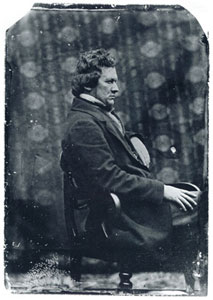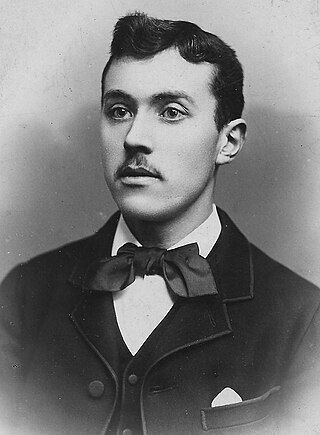The United Presbyterian Church (1847–1900) was a Scottish Presbyterian denomination. It was formed in 1847 by the union of the United Secession Church and the Relief Church, and in 1900 merged with the Free Church of Scotland to form the United Free Church of Scotland, which in turn united with the Church of Scotland in 1929. For most of its existence the United Presbyterian Church was the third largest Presbyterian Church in Scotland, and stood on the liberal wing of Scots Presbyterianism. The Church's name was often abbreviated to the initials U.P.

Alexander "Greek" Thomson was an eminent Scottish architect and architectural theorist who was a pioneer in sustainable building. Although his work was published in the architectural press of his day, it was little appreciated outside Glasgow during his lifetime. It has only been since the 1950s and 1960s that his critical reputation has revived—not least of all in connection with his probable influence on Frank Lloyd Wright.

Pollokshields is an area in the Southside of Glasgow, Scotland. Its modern boundaries are largely man-made, being formed by the M77 motorway to the west and northwest with the open land of Pollok Country Park and the Dumbreck neighbourhood beyond, by the Inverclyde Line railway and other branches which separate its territory from the largely industrial areas of Kinning Park, Kingston and Port Eglinton, and by the Glasgow South Western Line running from the east to south, bordering Govanhill, Strathbungo, Crossmyloof and Shawlands residential areas. There is also a suburban railway running through the area.

Thomas Hamilton was a Scottish architect, based in Edinburgh where he designed many of that city's prominent buildings. Born in Glasgow, his works include: the Burns Monument in Alloway; the Royal High School on the south side of Calton Hill ; the Royal College of Physicians of Edinburgh; the George IV Bridge, which spans the Cowgate; the Dean Orphan Hospital, now the Dean Gallery; the New North Road Free Church, now the Bedlam Theatre; Cumstoun, a private house in Dumfries and Galloway; and the Scottish Political Martyrs' Monument in Old Calton Cemetery, Edinburgh.

Crosshill is an area of Glasgow, Scotland. It is situated south of the River Clyde. It was an independent police burgh from 1871 to 1891 before being annexed by the City of Glasgow.
Blythswood Hill, centred on Blythswood Square, is an area of central Glasgow, Scotland. It extends from the west edge of Buchanan Street to Gordon Street and Bothwell Street, Charing Cross, Sauchiehall Street and Garnethill. Developed from 1800 onwards, its Georgian and Victorian architecture is a Conservation Area. It started as the "Magnificent New Town of Blythswood", becoming a part of the city-centre's business and social life.

The Empire Exhibition was an international exhibition held at Bellahouston Park in Glasgow, Scotland, from May to December 1938.

Cathedral Square is a public square in the city of Glasgow, Scotland. Cathedral Square and precinct is situated adjacent to Glasgow Cathedral on High Street/Castle Street at John Knox Street. Nearby are many famous Glasgow landmarks such as Provand's Lordship, Glasgow Royal Infirmary, the Necropolis, the ceremonial Barony Hall of Strathclyde University, and the Glasgow Evangelical Church at the Square. It is one of six public squares and precincts in the city centre.

Hippolyte Jean Blanc was a Scottish architect. Best known for his church buildings in the Gothic revival style, Blanc was also a keen antiquarian who oversaw meticulously researched restoration projects.

St. John's Renfield Church is a parish church of the Church of Scotland, serving Kelvindale in the west end of Glasgow, Scotland. It is within the Church of Scotland's Presbytery of Glasgow.

James Hoey Craigie TD FRIBA was a Scottish architect. He studied at the Glasgow School of Art. In 1894 he won the Alexander Thomson travelling scholarship which he spent in France and Italy. In 1905 he was made a partner in the firm Clarke & Bell, its name changing to Clarke & Bell & J H Craigie.

William Leiper FRIBA RSA (1839–1916) was a Scottish architect known particularly for his domestic architecture in and around the town of Helensburgh. In addition, he produced a small amount of fine ecclesiastical and commercial architecture in Glasgow and the Scottish Lowlands. He was also an accomplished watercolour artist, and from the late 1870s spent much spare time painting in oils and watercolours.

The Egyptian Halls is a category A listed building at 84–100 Union Street, Glasgow, Scotland. It was built between 1870–72 and designed by Alexander "Greek" Thomson. Other than some retailers on the ground floor, the building is currently unoccupied. Despite several attempts at restoration, it remains in a perilous state and was under threat of demolition in 2011. Planning approval and listed building consent has since been given for a scheme which has secured funding for conversion to a 114-bed four-star hotel. As of 20 February 2013, subsidy was still being sought for work to the ground floor.

St. Vincent Street, is one of the major streets in the city centre of Glasgow, Scotland. It was formed in the early 1800s as part of the residential New Town of Blythswood developed by William Harley of Blythswood Square. St. Vincent Street was named to commemorate the victory of Sir John Jervis, on 15 February 1797, off Cape Saint Vincent, Portugal. when the Royal Navy defeated the Spanish fleet which was on its way to join Napoleon's French fleet.

The church is named after Saint Mungo, patron saint and founder of the city of Glasgow. It belongs to the Church of Scotland Presbytery of Stirling and serves the parish of Alloa. A chapel dedicated to St Mungo is thought to have been erected during the fourteenth or fifteenth-century, which became dependent upon the Parish of Tullibody. Alloa had grown into a parish in its own right by 1600 when the Act of Assembly united the two parishes. In 1680, the original chapel was rebuilt and enlarged. The current church replaces the old parish church from the seventeenth-century which had been deemed much too small for the congregation for over seventy years and was declared ruinous and unsafe in August 1815. The condition of the old church was so bad that services were often being held in the open air rather than risking injury to the congregation The decision was finally made to abandon the old building and find a site for a new parish church. The Erskine family donated land at Bedford Place and work on the new St Mungo's church began in 1817. The church congregation temporarily worshipped in the Tabernacle until the completion in 1819 of the new church. Since land was judged at the time to have too great a value to the living to be set aside for the dead, no graveyard was planned or added to the new church. The more elaborate scale and design of the new building was intended to reflect the increased size and prosperity of the nineteenth-century congregation. The church was one of the largest in Scotland at the time it was built.

Thomas Gildard was a 19th-century Scottish architect and author. In a short career as a private architect alongside Robert Macfarlane, before entering public service as deputy to Glasgow`s Master of Works, buildings designed by him and his professional partner are : the Clyde Thread Works, also known as Clyde Thread Mills; Belgrave Terrace on the southside of Great Western Road, Glasgow; Ardenvhor fronting the Gareloch; and in 1857/58 an Italianate warehouse in the Trongate, Glasgow for Archibald Blair, two floors of which opened on 25 December 1859 as the Britannia Music Hall.

Robert Gordon Wilson (1844–1931) was a 19th/20th century Scottish architect based in Aberdeen. He was from a strong United Presbyterian background and specialised in churches for the United Presbyterian Church and Free Church of Scotland.
William Erskine Thomson was a Scottish architect prominent in the late 19th and first half of the 20th centuries. He designed several notable buildings in Scotland, mostly including churches and villas. Several of his works are now listed structures.

Caledonia Road Church, formerly Caledonia Road United Presbyterian Church and Hutchesontown and Caledonia Road Church, is a ruined church in Glasgow, Scotland. In 1966 the building was added to the Scottish Heritage List as Category A.

















